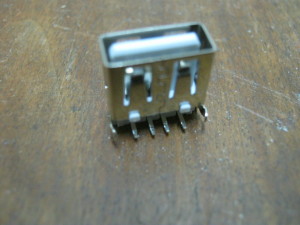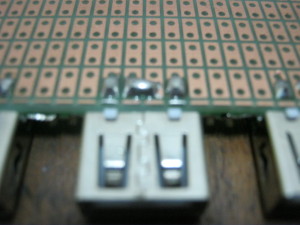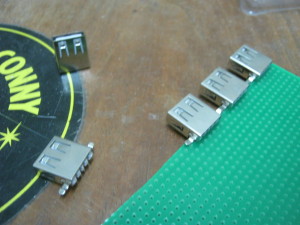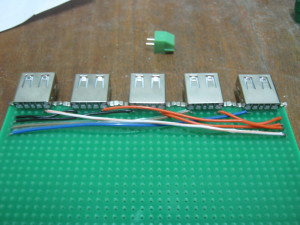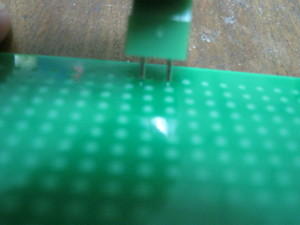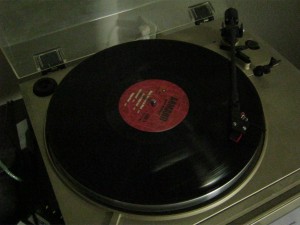My second Raspberry Pi still powered on and connected to my LAN. That’s how I left to stack last Thursday. So, I SSH’ed into my first Pi, and from there, being inside my lan, I SSH’ed to my second Pi. Let’s do something with it, shall we? As this is a fresh installation, we have some configuration to be done. Let’s start with installing yaourt. On ArchLinuxARM we don’t need to add a repository like we should on regular ArchLinux.
[root@alarmpi ~]# pacman -S yaourt
As this Pi is connected to a screen, let’s get some graphical enviorement
[root@alarmpi ~]# pacman -S xorg xorg-apps xfce4 xfce4-goodies gdm
Note gdm seems to have some weird dependencies such as pulseaudio and flac. I assume because it makes some sound during login. I’ve tried lightdm instead but it doesn’t work on my Raspberry Pi.
Also base-devel is not installed, so we cannot compile anything, and the locale needs to be fixed, as I described in the other Pi installation, which I should also continue to write about. I have an unfinished post on concept for like…. ages. And I have a lot more to do on that other Pi… Anyhow, that’s all what I did last thursday, at least, to the Pi, as I went to the pub that night. It was 20 December after all, so, as the world was supposed to end the day after, it was my last chance to have some beers with friends.
So, 20 December 2012, I was at a pub until late at night. The result was I overslept the next day and missed the end of the world. And since I missed it, and was apparently still alive, I decided to continue playing around with that second Pi.
Since all the graphical stuff takes a lot of space, we should resize the file system to occupy the whole SD card. How to resize it is described on the ArchLinuxARM forum. It just tells you what to enter, but let’s take a look at what we’re actually doing
[root@alarmpi andre]# fdisk /dev/mmcblk0
Welcome to fdisk (util-linux 2.22.1).
Changes will remain in memory only, until you decide to write them.
Be careful before using the write command.
Command (m for help): d
Partition number (1-4): 2
Partition 2 is deleted
Command (m for help): n
Partition type:
p primary (1 primary, 0 extended, 3 free)
e extended
Select (default p): p
Partition number (1-4, default 2): 2
First sector (194560-31512575, default 194560):
Using default value 194560
Last sector, +sectors or +size{K,M,G} (194560-31512575, default 31512575):
Using default value 31512575
Partition 2 of type Linux and of size 15 GiB is set
Command (m for help): w
The partition table has been altered!
Calling ioctl() to re-read partition table.
WARNING: Re-reading the partition table failed with error 16: Device or resource busy.
The kernel still uses the old table. The new table will be used at
the next reboot or after you run partprobe(8) or kpartx(8)
Syncing disks.
We’re deleting the rootfs partition, and creating a new one. Since there is no space between the boot and the root partition in the first place, the new partition will start at the exact same position as the just deleted partition. This means, we’ve got a bigger partition, with a smaller filesystem in there.
We also observe the re-reading of the partition failed, since the partition is currently in use. Therefore we have to reboot in order for the new partition table to be known to the kernel. After reboot we can perform the resizing of the file system itself
[root@alarmpi andre]# resize2fs /dev/mmcblk0p2
resize2fs 1.42.6 (21-Sep-2012)
Filesystem at /dev/mmcblk0p2 is mounted on /; on-line resizing required
old_desc_blocks = 1, new_desc_blocks = 1
Performing an on-line resize of /dev/mmcblk0p2 to 3914752 (4k) blocks.
The filesystem on /dev/mmcblk0p2 is now 3914752 blocks long.
Now, we’re occupyting the whole SD card. So… setting up graphical enviorement. We’ve got some more disk space now, let’s install a browser.
[root@alarmpi andre]# pacman -S midori firefox
error: target not found: firefox
Hmmm…. firefox not found… apparently not in the repository. (Neither is thunderbird) More stuff I have to compile myself, just like I had to compile qemu. Perhaps I should really look into how to set up my own repository. For now, let’s install some other browsers.
[root@alarmpi andre]# pacman -S links midori netsurf
Links for when I am using a console. Perhaps I should better install elinks. Midori is a webkit browser. Should be fine for normal surfing but has some rough edges. At least last time I used it on my x86_64 machine. Netsurf, it is the default browser on the RISCOS image for the Raspberry Pi. That’s when I first heard of it.
Another this that cannot be missed on a graphical installation is an IRC client. Recently I have migrated from Xchat to Hexchat, since the latest Xchat release is over two years old. As Hexchat is in AUR, we need to compile it ourselves. While installing, I ran into the following error.
==> ERROR: hexchat is not available for the 'armv6h' architecture.
Note that many packages may need a line added to their PKGBUILD
such as arch=('armv6h').
==> ERROR: Makepkg was unable to build hexchat.
==> Restart building hexchat ? [y/N]
==> --------------------------------
==>
It happens on some packages. Note that AUR is meant for ArchLinux, and that ArchLinuxARM is just using their AUR. They could have set arch=(‘any’) and it would have compiled anyways, but i686 and x86_64 are the official supported architectures, therefore putting those in the arch array makes perfect sense. Just edit the PKGBUILD and add ‘armv6h’ to the arch array, and it will work fine. They should have used any. The specefic i686 and x86_64 should only be used for binary packages (skype, dropbox, opera and other proprietary someware *shiver*) or software written in assembly (not aware of any)
Compiling takes long, especially on an ARM board. Therefore, during compiling I decided to install some more software. Qmmp is the music player I usually use on my Linux boxes. I used to use xmms in the past, but it being a gtk1 application, it’s considered a dinosaur. Some distros ditched it years ago, but Arch still has it in its repository.
But doing this on a Raspberry Pi Model B Revision 1, with only 256 MB of shared RAM, well…. it ran out of RAM, and both terminals were closed. (My XFCE was running already) I need to connect a USB Hard Disk with a swap file and home partition. Compiling stuff on a SD card, it’s not a wise thing to do. Too many writes and a limited number of write cycles. I would like to use the SD for a little longer.
I know it’s not wise, but I’ve tried another attempt building hexchat, this time, not doing other things with the Pi during the build.
==> Tidying install...
-> Purging unwanted files...
-> Compressing man and info pages...
-> Stripping unneeded symbols from binaries and libraries...
-> Removing libtool files...
==> Creating package...
-> Generating .PKGINFO file...
-> Adding install file...
-> Compressing package...
bsdtar: Failed to set default locale
xz: (stdin): Cannot allocate memory
bsdtar: usr/share/locale/lv/: Write error
==> ERROR: Failed to create package file.
==> ERROR: Makepkg was unable to build hexchat.
==> Restart building hexchat ? [y/N]
==> --------------------------------
==>
So, it actually finished, but ran out of memory during the package creation. We really need that hard disk… But…. what hard disk to use? I have three external hard disks connected to my server Pi, but they’re in use. I have one more external HD. I wasn’t sure what was on it, but… there is stuff on it, and it’s full. A 500 GB Hard Disk… Backing the data up to my desktop… well… all it’s hard disks are smaller. One hard disk, containing a Windows 8 Developer Preview and an OpenIndiana installation, but mostly unpartitioned space. OpenIndiana isn’t really usefull on that machine, and I haven’t booted it since… long ago. And well… Windows… I don’t think I need to explain. So… that hard disk had been extracted from my desktop (blaatkonijn) and connected using a USB-IDE adaptor.
I’ve recently ordered an USB->IDE/SATA at dx.com. It looks exactly like my USB->IDE except for the SATA connector at the top. My USB->IDE power supply came with a switch in the cable, which the USB->IDE/SATA one lacked. More overly it came with a type B power plug.


Even though it comes with a type B power plug, mostly used in the United Stated (120 VAC) and Japan (100VAC), the power adaptor says 100-240 VAC, so just connecting a different cable should do the trick. Still I was a little suspicious, as when inserting the power cable, it made this clack noise as if its initial current was rather high. Therefore I have verified the output voltages with a multimeter before connecting any hard disks to it. This is something I’ve done a few weeks ago.
Anyhow, I’ve decided to use that power adaptor, as I don’t need the switch, and I started to parition it. GParted refused to start, due incorrect locale. The locate problem, for now, I just did a export LC_ALL="C", but this was another problem that needed to be fixed. Well… GParted working on C locale. How big should I make the swap partition? I’ve made it 8 GB. It’s insane, but better too much then too little, and the rest of the disk as home partition.
As I am configuring my fstab anyways, let’s take care of my network mounts as well.
[root@alarmpi andre]# pacman -S nfs-utils
This results in the following entries added to my fstab
UUID=5d44c79b-7fc0-4711-a9f5-73dcaea98275 swap swap defaults 0 0
UUID=839de469-ef9d-48a7-aedd-d2a6b05f1a5f /home ext4 defaults 0 2
rpi-server:/srv/nfs4/1000 /mnt/1000 nfs defaults 0 0
rpi-server:/srv/nfs4/1500 /mnt/1500 nfs defaults 0 0
At first I put nfs4, but it didn’t work yet, so I am using nfs3 instead. Looking at my other machines, they’re also using nfs3, so that’s consitent with the rest of my installation. I should look at how to migrate to nfs4, but nfs3 is good enough for now.
Why did I mention that power adaptor? Well… it went poof and blew my fuse after operating for a while. At least, I blaim that thing for my blews fuse, as it was rather hot and smelled burnt, and I had a feeling about it since I got it. Hooray, I had a little mini tiny apocalypse, a blown fuse.
Connecting my other power supply, the one with the switch, which came with this USB->IDE adaptor, everything works fine. This power supply remains at a normal temperature, and has been running for quite a while without problems. However, now I don’t have any power supply for the other USB->IDE/SATA adaptor.
As this post is getting lengthy, this is where I stop. More will follow in a next post, as there are some more things I’ve encountered. I mean, a lot has happened while waiting for the world to end. Also, a package with a 5¼” floppy drive I’d bought on ebay arrived



